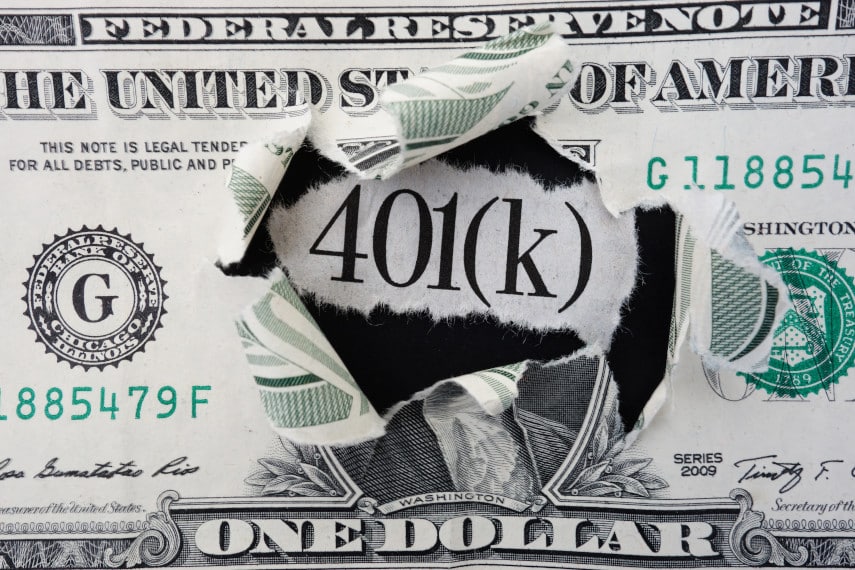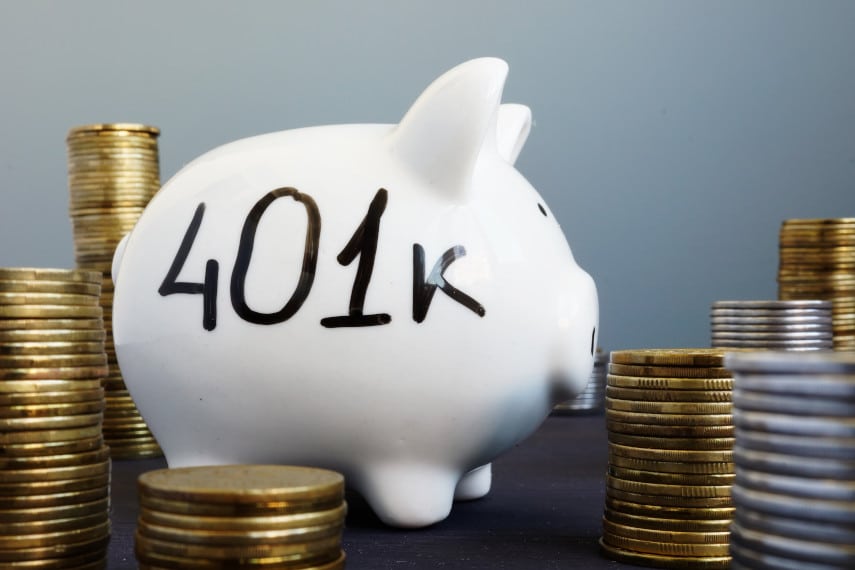
Americans today hold trillions of dollars in retirement savings. Much of that money is held in 401(k) accounts, the dominant form of employer-sponsored retirement account.
With the stock market’s performance since 2016, many Americans have become 401(k) millionaires. But while becoming a 401(k) millionaire may have come relatively easily to some people, keeping that money safe isn’t quite as simple.
The US economy increasingly seems to be headed toward recession. Inflation remains elevated and stubbornly out of control, interest rates are at the highest levels they’ve been in over 15 years, and various indicators throughout the economy indicate a tough time ahead.
That’s why more and more Americans today are looking to protect themselves and their wealth against financial loss. With stock markets having lost more than 50% of their value during the 2008 financial crisis, no one today wants to see those kinds of losses today.
Those Americans with significant amounts of money in 401(k) accounts are looking for alternative investments to protect their retirement savings. But how easy is it to find alternative 401(k) investments?
Types of Retirement Plans
There are numerous types of retirement plans, but we’ll focus on three of the most common categories. These are defined benefit plans, defined contribution plans, and IRA accounts.
1. Defined Benefit Plans
A defined benefit plan is a retirement plan that promises to pay a defined benefit in retirement. For instance, these types of plans may offer to pay $1,000 per month in retirement, or they may promise to pay a certain percentage of the average of your three highest-paid salaried years in retirement.
Pension plans are the most well known type of defined benefit plan, and for many years they were one of the most common employer-sponsored retirement plans. But pension plans have numerous drawbacks that have caused them to lose popularity.
The way these plans work is that employers set aside a certain amount of money each pay period for each employee. Sometimes this comes out of an employee’s paycheck, or often it is an additional expense borne by the employer.
These funds are then invested in various investments, which could be stocks, bonds, CDs, money market accounts, etc. The pension plan’s administrators assume a certain average rate of growth each year, and allocate enough money to the pension plan to meet pension demands based on that rate of growth.
The problems with pension plans are threefold.
First, if the rate of growth of the pension plan’s investments doesn’t keep pace with actuarial forecasts, the plan won’t have enough money to pay out expected benefits. This then requires that either employees pay more into the system or that employers increase the amount they contribute, neither of which is always feasible.
Secondly, pension demands may increase as more employees retire. This can draw down the funds of the pension plan quicker than expected.
Finally, the company may go out of business, leaving its employees in the lurch. While the government-chartered Pension Benefit Guaranty Corporation (PBGC) is responsible for taking over failed pension plans, very often the recipients of these failed plans can’t expect to get the full benefits they otherwise might have received.
Today few companies offer defined benefit plans anymore. Defined benefit plans are largely confined to the government sector, such as the federal government’s FERS and CSRS systems, state employee pension plans, or teacher pension plans.
Many of these plans too suffer from underfunding due to overly optimistic forecasts for investment growth. And many government employees who had expected to receive pensions in retirement may find out the hard way that their expected benefits won’t materialize.
While many pension plans may have expected 7-8% annualized growth rates over the long term, which is in line with long-term historical trends, the reality today is far different. The Dow Jones Industrial Average and the S&P 500 index have grown 7.2% and 7.5% per year respectively since 1971.
But since 2001, they have only grown 5.2% and 5.3% respectively. Unless that changes significantly in the near future, pension plans may remain chronically underfunded.
2. Defined Contribution Plans
Defined benefit plans have largely been replaced by defined contribution plans at most employers. Rather than paying a defined benefit at retirement, these defined contribution plans allocate a certain amount of money each pay period, which employees can then invest as they see fit.
The dominant form of defined contribution plan today is the 401(k) plan. Americans today hold $10.2 trillion in defined contribution plan accounts, of which $7.2 trillion are in 401(k) accounts.
With a 401(k) account, you can choose either to allocate a certain percentage of your salary each pay period to your employer-sponsored retirement account or a certain dollar amount. The amount of money you are allowed to allocate to these accounts is limited each year to $22,500, or $30,000 if you’re over age 50.
Additionally, employers are able to make contributions to 401(k) accounts on the employee’s behalf. Very often this is done in the form of matching contributions, in which employers will match up to a certain percentage of contributions.
So if an employer will match 1-to-1 up to 5%, an employee who allocates 3% of his salary to a 401(k) would receive an identical amount of money contributed by the employer to his 401(k) account. An employee who allocates 5% or more would then receive the maximum 5% employer matching contribution.
These matching contributions are why you’ll often hear people advising employees to take the company match. It’s essentially free money that the employer is offering its employees. Yet many people still leave that money on the table.
Employers prefer defined contribution plans for a number of reasons. For one thing, it takes all the pressure off the employer and places it on the employee.
No longer do employers have to worry about actuarial estimates and funding pension plans. Now the responsibility is on employees to put aside enough money out of their paychecks to build up their retirement savings.
This makes it a lot cheaper for companies to administer defined contribution plans. In many cases these plans are administered by third parties, which further reduces the expenses a company has to pay out for its employees’ retirement costs.
401(k) accounts are popular with employees because of their tax benefits as tax-deferred accounts. The money that is taken out of your paycheck to deposit into your 401(k) account is not taxed as income. So if you make $100,000 in salary but put $15,000 of that into a 401(k), you’ll only pay income tax on $85,000.
The investments you make with a 401(k) account are also not taxed until you take a distribution. So you could have money working for 20-30 years or more within a 401(k) account, and any earnings, capital gains, or dividends that remain in that account won’t be taxed until you decide to withdraw them, which normally you would only do in retirement.
There are penalties for taking distributions from a 401(k) account before age 59½, in addition to any income taxes you may owe.
Roth 401(k) accounts are growing in popularity today too. Unlike conventional 401(k) accounts, the contributions to a Roth 401(k) come from post-tax dollars, so they don’t reduce your taxable income.
But the contributions to a Roth 401(k) do grow tax-free, and when you take a distribution, it is tax-free. After 2024, Roth 401(k) accounts will also no longer be subject to required minimum distributions (RMDs).
3. IRA Accounts
The other major type of retirement account is an IRA, which stands for individual retirement account or individual retirement arrangement. Americans actually hold more money in IRA accounts than any other, a total of $13 trillion.
Unlike defined contribution accounts, IRA accounts are normally not employer-sponsored accounts, although there are some exceptions. IRA accounts are generally set up by an individual for retirement, with the account being administered by an IRA custodian.
In a way, IRA accounts are like a cross between a brokerage account and a 401(k) account in that they are able to invest in a wider variety of assets like a brokerage account, but they have the same tax advantages as a 401(k) account. The major disadvantage for an IRA versus a 401(k) is that the maximum annual contribution for an IRA is $6,500 per year ($7,500 if you’re over age 50) versus $22,500 ($30,000 over 50) for a 401(k).
Traditional IRA accounts are funded with pre-tax dollars and accrue gains tax-free just like a 401(k) account, and taxes are paid when you take a distribution. Below certain income limits, contributions to a Traditional IRA may even be tax-deductible.
Roth IRA accounts are funded with post-tax dollars just like a Roth 401(k), gains accrue tax-free, and no taxes are paid when you take a distribution. Roth IRA accounts are also not subject to RMDs, unlike Traditional IRAs, which require that RMDs be taken starting at age 73.
There are other types of IRA accounts too, such as SEP IRAs and SIMPLE IRAs, each with their own sets of rules. But because they’re generally limited to self-employed people and very small businesses, we won’t get into too much detail about them here.
What Assets Can 401(k) Accounts Hold?
If you have a 401(k) account, you’re likely familiar with some of the assets that a 401(k) can invest in. 401(k) accounts can invest in stocks, bonds, various funds, or if you’re lucky even cash.
The exact mix of assets your 401(k) account can invest in is dependent on the plan your employer offers and who is administering the plan. Some 401(k) plans offer a wider range of investment choices than others.
In most cases, though, you’re not going to be able to buy much more than stocks, bonds, and shares in funds with your 401(k). Because 401(k) accounts are sponsored by employers and are offered as a job benefit, they’re overseen by the Department of Labor (DOL).
While DOL could authorize 401(k) accounts to allow a wider range of investment choices, DOL has been hesitant to do so. The Department tends to prefer that 401(k) plans not offer investment choices with limited markets, opaque valuation, or complex pricing structures.
Because most people are familiar with stocks, bonds, and funds, that’s what DOL feels comfortable permitting 401(k) accounts to invest in. While there has been a push to allow 401(k) plans to allow investments in private equity, private real estate, and other alternative assets, DOL is putting the brakes on that movement.
What Assets Can IRA Accounts Hold?
In contrast, IRA accounts can invest in a wide range of assets. Depending on who your IRA custodian is, your asset choices are nearly unlimited.
Your average IRA custodian has access to thousands of different investment products, from stocks, bonds, and CDs to futures, options, and IPOs. And those aren’t even the full range of options you have.
The only things an IRA can’t invest in are collectibles, as defined in 26 U.S.C. 408(m). Collectibles include works of art, rugs and antiques, metals, gems, stamps and coins, alcoholic beverages, and anything else the Treasury Secretary declares to be a collectible.
There are, however, important exceptions to that collectible definition, namely that the definition of collectible does not include the gold, silver, and platinum American Eagle series of coins produced by the US Mint, nor does it include any gold, silver, platinum, or palladium bullion that is manufactured with a fineness that meets or exceeds minimum fineness requirements for contract markets.
What this means is that any gold, silver, platinum, or palladium bullion coin that meets or exceeds these fineness requirements is eligible to be acquired by an IRA account. This is why you are able to start a gold IRA or silver IRA and purchase gold and silver coins or bars.
Gold and silver IRAs aren’t super common, as most IRA custodians aren’t set up to administer these kinds of alternative assets. Gold and silver IRAs are a type of self-directed IRA, an IRA in which you as the account holder exercise greater control over your investments.
Self-directed IRAs can invest in numerous types of alternative investments, including private equity, private debt, real estate, commodities, and precious metals like gold and silver. More and more people are learning about self-directed IRAs and taking advantage of them to broaden the scope of their investment portfolios.
One of the common methods of funding a gold IRA or silver IRA is to roll over funds from a 401(k) or similar account into an IRA. This 401(k) to IRA rollover is a well known technique to get around the maximum annual contribution limit to IRA accounts, as rollovers don’t count against your annual contribution limit.
You can roll over $10,000, $100,000, or even $500,000 or more from a 401(k) account into an IRA. And in most cases you can do that without having to pay any taxes or penalties.
Rollovers are not subject to age-based penalties, such as the 10% penalty on distributions taken before age 59½. So if you’re in your 40s and want to roll over $60,000 from a 401(k) account to an IRA, you can do that tax-free.
Just about the only time you’ll face taxation issues is if you’re attempting to move funds from a pre-tax account (401(k), 403(b), TSP, Traditional IRA, etc.) to a Roth account (Roth 401(k) or Roth IRA). These types of rollovers are called Roth conversions, and you will have to pay taxes on that conversion.
If that’s something you’re interested in doing, you’re probably going to want to consult with a tax advisor to make sure that you’re doing everything properly and not subjecting yourself to unexpected tax consequences.
Does a Gold IRA Make Sense for You?
Gold IRAs are becoming an increasingly popular way for many people to protect their retirement savings. The rollover process to fund a gold IRA is relatively straightforward, and in many cases you can have a gold IRA set up and funded within a couple of weeks.
Gold has been trusted as a safe haven asset and store of value for centuries, and has a reputation for protecting wealth through tough times. With the US economy potentially facing a severe recession, demand for gold has been strong for quite a while, and may only get stronger once a recession occurs.
Goldco has helped thousands of people benefit from owning gold, and our over 5,000 5-star reviews are a testament not only to the quality of the gold coins we sell, but also to our commitment to exemplary customer service.
Placing your hard-earned retirement savings into gold can be nerve-wracking for many people, especially if it’s your first time owning gold. But Goldco’s experienced professionals can help you through this process.
From answering your questions about how a gold IRA works, to processing your order for high quality gold coins that we source directly from the mints that produce them, to making sure that your gold is safe at a bullion depository of your choosing, Goldco stands ready to do what we need to ensure that you are happy with your decision to purchase gold.
If you’re looking at your 401(k) and are interested in alternative investments like gold and silver, call Goldco today to learn more about how precious metals like gold and silver can help you safeguard your savings.






